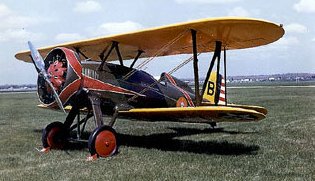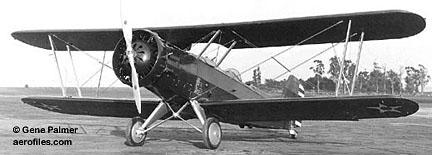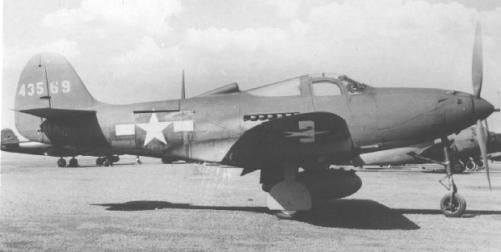A Series
(A-1 through A-8)
Between 1940 and June 1941, the USAAC used an A-for-Aerial Target designation category for radio-controlled aircraft used as gunnery targets. However, these designations could be easily confused with the A-for-Attack series, and therefore the A-series was replaced by two new categories: OQ for subscale target drones, and PQ for full-scale aircraft with provision for an on-board pilot. Existing A-series drones were redesignated in the appropriate new category with their model numbers unchanged. The redesignations affected only two models, the Radioplane A-2 (becoming the OQ-2) and the Culver A-8 (becoming the PQ-8). Both OQ- and PQ-series were then continued from their first members, leaving OQ-1 and PQ-1 through -7 unassigned. Because the PQ-series therefore started off from the last A-series target, the PQ-series was effectively a continuation of the A-series.
Fleetwings A-1
The A-1 was built around 1940 as a small aerial gunnery target, probably designed specifically for this purpose. It had a wingspan of around 6 m (20 ft), was powered by a 60 kW (80 hp) piston engine, and could reach a speed of 290 km/h (180 mph) at altitudes of at least 3000 m (10000 ft). The A-1 was flown unmanned and controlled by radio commands from the ground. There is no data available on the number of A-1s built or their service career, but the target was most likely no longer used by mid-1941.
Radioplane A-2
The A-2 was redesignated in June 1941 as OQ-2, q.v.
Curtiss A-3
In the late 1930s, the U.S. Navy converted a few surviving obsolete Curtiss N2C-2 Fledgling training biplanes to radio-controlled target drones. These drones were modified with a tricycle landing gear, and could be remote-controlled either from a ground station or another aircraft. In 1940, the Army tested at least one of these conversions as the A-3 powered target.
 |
| Photo: © Gene Palmer, Aerofiles |
| N2C-2 drone (A-3) |
Douglas A-4
In 1940, the USAAC converted 15 BT-2B and two BT-2BI basic trainer biplanes to radio-controlled target drones. These aircraft were initially designated BT-2BR and BT-2BG, respectively, but these designations were eventually dropped in favour of A-4 for both types of conversions.
 |
| Photo: USAF |
| A-4 |
The rear cockpit was faired over, but for check-out flights the A-4 could still be flown as a single-seater. To facilitate landings under remote control, the A-4 was fitted with a tricycle undercarriage and a steerable nosewheel. The drone was controlled in flight by a BT-2CR (modified BT-2C) control plane. Photographic evidence suggests that some A-4s were still in the inventory as late as August 1941, when the PQ series for full-scale targets had already been introduced. Said photos are actually labeled "PQ-4" in some cases, but this was most likely not an official designation.
Boeing A-5
The designation A-5 was reserved in 1940 for the conversion of a single Boeing P-12E biplane fighter to a radio-controlled target drone. However, around that time the Army abandoned its plans to convert obsolete service aircraft to target drones, and therefore the A-5 never materialized.
 |
| Photo: Air Force Museum Foundation |
| P-12E |
Douglas A-6
The designation A-6 was reserved for conversions of surplus Douglas O-38 biplanes to radio-controlled target drones. However, no O-38s were converted to A-6 configuration. The O-38 was very similar to the BT-2 trainer, and therefore the A-6 would probably have been similar to the A-4.
 |
| Photo: © Gene Palmer, Aerofiles |
| O-38B |
Bell A-7 Airacobra
The designation A-7 was reserved for conversions of Bell P-39 Airacobra fighters to radio-controlled target drones. No P-39s were converted to A-7s by the U.S. Army Air Force, but the U.S. Navy converted at least three P-39Qs to drone configuration and tested them under the designations XTDL-1 and F2L-1K.
 |
| Photo: The Aviation History On-Line Museum |
| P-39Q |
Culver A-8 Cadet
The A-8 was redesignated in June 1941 as PQ-8, q.v.
Specifications
Note: Data given by several sources show slight variations. Figures given below may therefore be inaccurate!
Data for N2C-2 (A-3 was similar), BT-2B (A-4 was similar):
| N2C-2 | BT-2B | |
|---|---|---|
| Length | 8.33 m (27 ft 4 in) | 9.50 m (31 ft 2 in) |
| Wingspan | 12.01 m (39 ft 5 in) | 12.19 m (40 ft) |
| Height | 3.26 m (10 ft 8.5 in) | 3.20 m (10 ft 6 in) |
| Weight | 1300 kg (2860 lb) | 1840 kg (4060 lb) |
| Speed | 187 km/h (116 mph) | 216 km/h (134 mph) |
| Ceiling | 5430 m (17800 ft) | 5850 m (19200 ft) |
| Range | 618 km (384 miles) | 515 km (320 miles) |
| Propulsion | Wright R-760-94 piston engine; 178 kW (240 hp) | P&W R-1340-11 piston engine; 333 kW (450 hp) |
Main Sources
[1] John M. Andrade: "U.S. Military Aircraft Designations and Serials, 1909 to 1979", Midland Counties, 1979
[2] Gordon Swanborough, Peter M. Bowers: "U.S. Military Aircraft since 1908", Putnam, 1989
[3] René J. Francillon: "McDonnell Douglas Aircraft since 1920", Putnam, 1988
[4] Peter M. Bowers: "Boeing Aircraft since 1916", Putnam, 1989
[5] Gordon Swanborough, Peter M. Bowers: "U.S. Navy Aircraft since 1911", Putnam, 1989
[6] US Army Air Forces: "Army Aircraft Model Designations", 1946
Back to Directory of U.S. Military Rockets and Missiles, Appendix 1
Last Updated: 23 November 2009